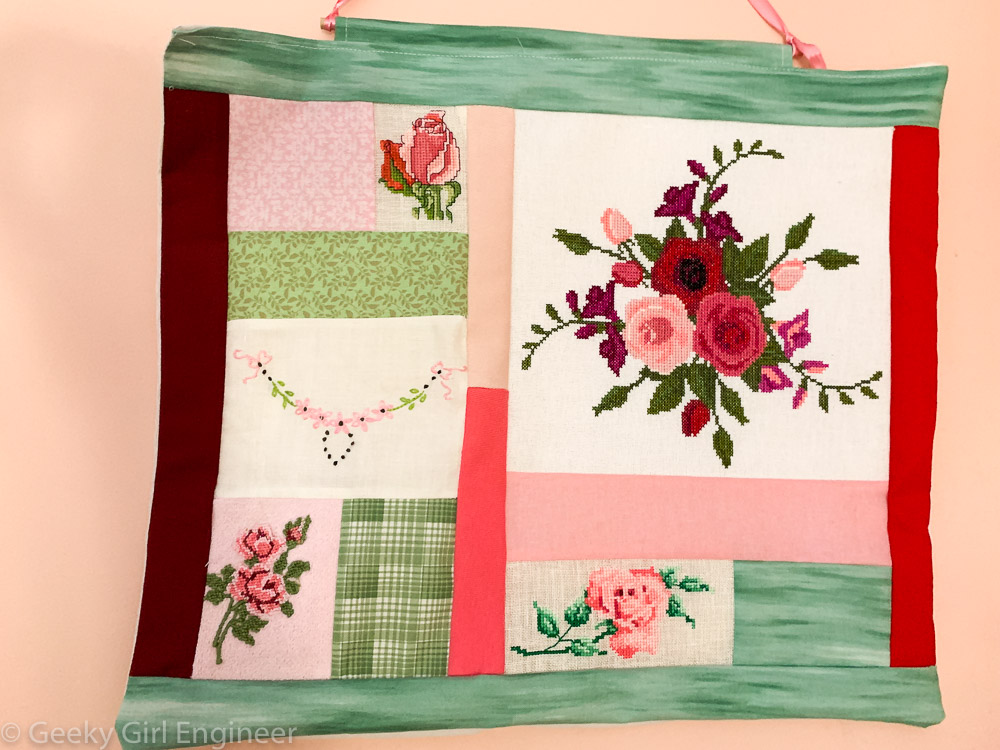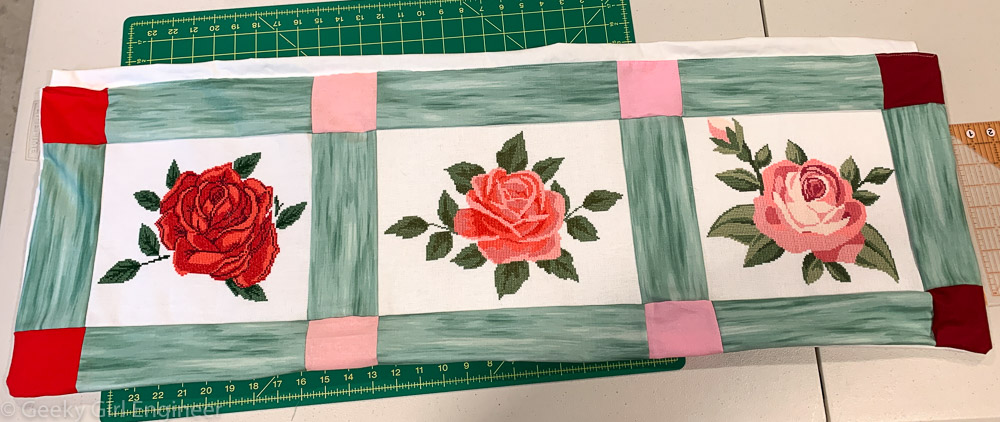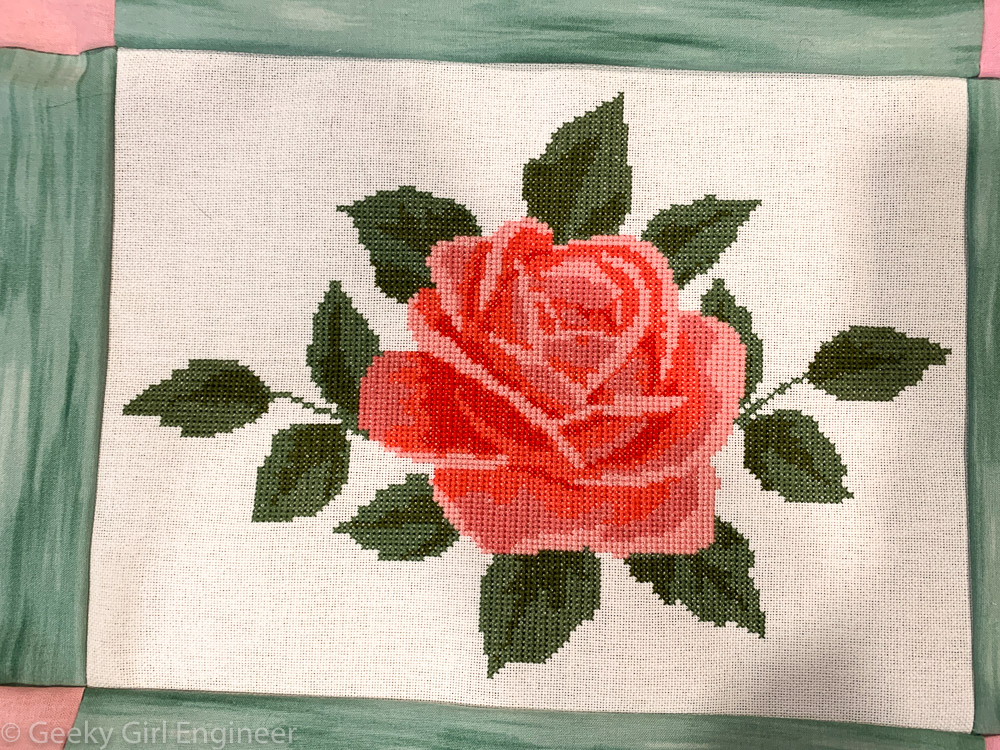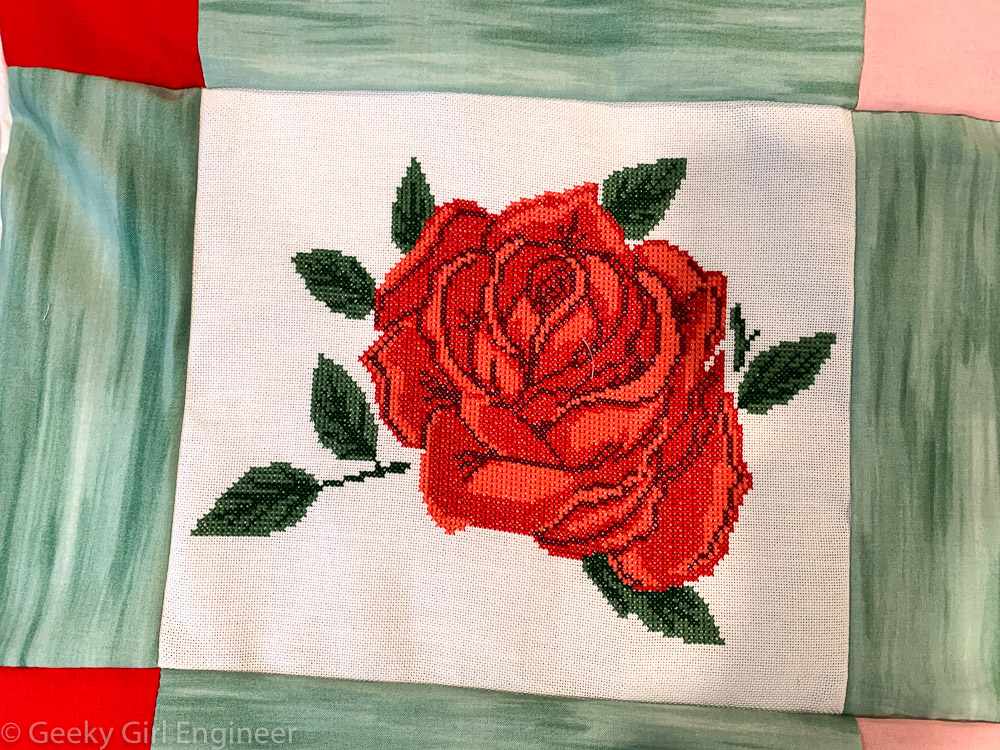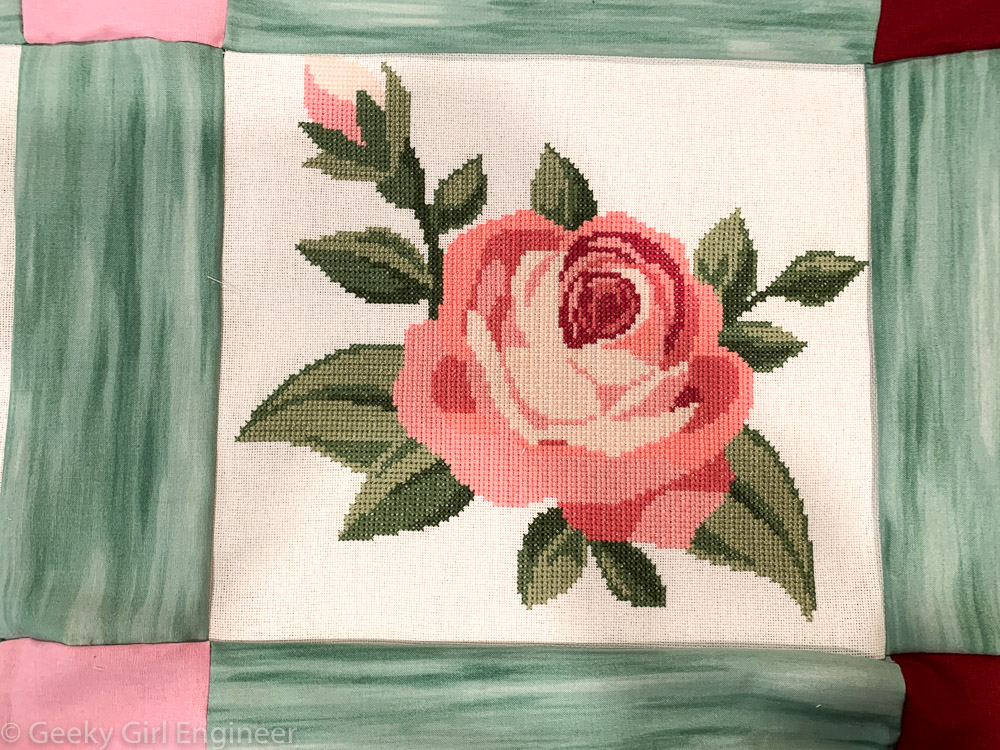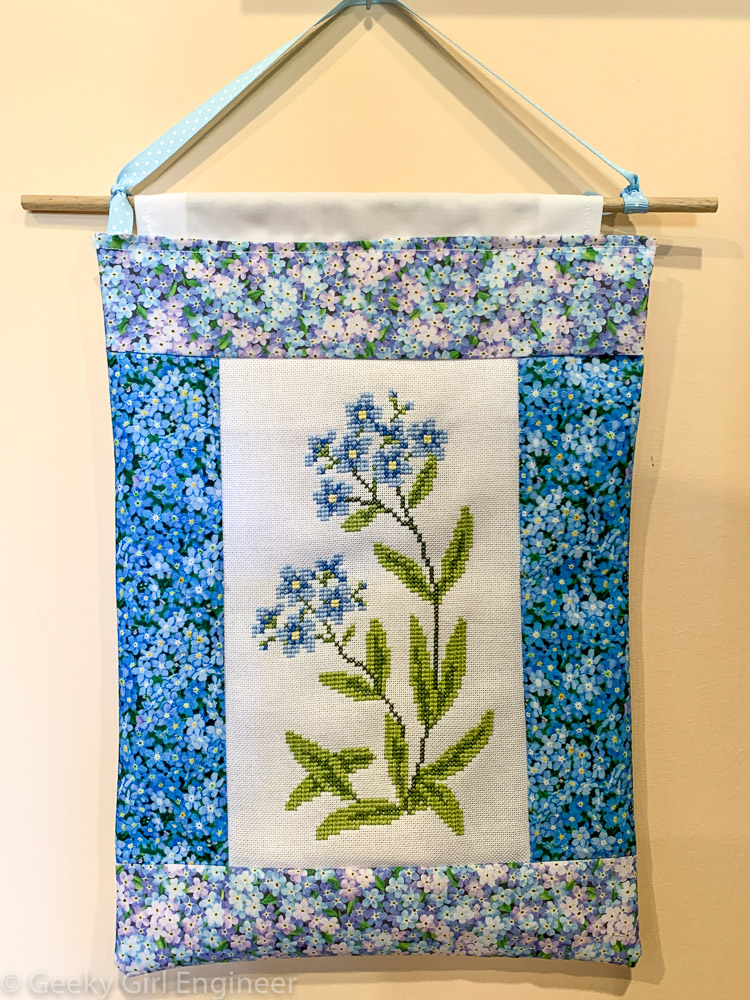After I made the wall hanging with the three cross-stitched roses, I wanted to experiment a bit and make another wall hanging with a variety of fabrics. The main purpose of the wall hanging was to find a way to display a large cross-stitch with flowers (upper right). I had two other small cross-stitch flowers that I added to the wall hanging. These are the rose bud in the upper left and the rose in lower center. I used it as an opportunity to patch together a couple of different types of fabrics. The lower left corner rose is an appliqué that is on a cotton towel that I cut. The flower garland embroidery pattern piece from a linen towel. The two vertical center solid pink pieces are from old clothing. The top pale pink is from denim jeans, and the lower bright pink is from a cotton shirt. The rest of the fabric is quilt weight cotton fabric. The different fabrics made it a bit more difficult to sew and square things, but it was a learning opportunity.
Tag Archives: sewing
Cross-stitched roses wall hanging
During COVID, I have been doing a lot of cross-stitching. Then of course, the question is what to do with all these finished cross-stitched projects. Wall hangings are rather easy and give me a way to display them. I found patterns for three lovely roses on Etsy by the same artist, so I decided to finish them as one wall hanging. I used coordinating green fabric to frame each with four different colors of reds and pinks to emphasize the colors of each rose.
This wall hanging also gave me practice sewing. If you look carefully, you can tell, I still need practice sewing. [Although I have done a lot of sewing since I made this months ago.] My main issue is getting pieces to meet and square properly. I think part of the problem, at least for the below project, is that the framing fabric is standard cotton fabric, perfect for quilting. The cross-stitches are obviously done on a different type fo fabric. These are on linen. The fabrics stretch slightly different, and I think that is leading to some problems. Clearly I just need to keep stitching and sewing and practicing more.
Framing a cross-stitch with fabric
With the exception of my really big cross-stitch projects, I don’t frame them. Very often I finish them by putting them on a patted mat board that I then finish with a ribbon to hang them. I really like doing this in particular for holiday and seasonal cross-stitch projects as it makes it easier to take them down and store them until I want to hang them again.
While I was in Alaska on vacation this summer, I bought some wonderful cross-stitch patterns designed by an artist there of Alaska flowers. One pattern was fireweed, and another pattern was forget-me-nots. I loved stitching patterns that represent and remind me of a place I have visited, in this case Alaska. While there, I also found some wonderful fabrics that also showcase Alaska. Fortuitously, I found some fabric printed with fireweed and forget-me-nots, so I used those fabrics to frame the cross-stitch projects.
I just sewed some simple blocks to frame the cross-stitch patterns. I then sewed a back sort of like I was making a pillow. I just didn’t put a pillow in between the front and back. I then sewed a sleeve to the top, put a wooden dowel through the sleeve, and tied a ribbon to hang it.
My Newest Hobby
I am the type of person who always has to be doing something. It is not exactly that I can’t keep still. It is more that I feel like I always have to be productive. I grant you there are different definitions of what is and is not productive. I generally can’t just watch television. I need to have my hands doing something. [OK maybe I can’t keep still.] That could be something mindless on the computer, but most of the time, I cross-stitch while watching television. I can sit and relax and watch television, but I am still productive as I cross-stitch. Especially since the COVID-19 pandemic, I have gotten a lot of cross-stitching done because I don’t leave the house near as much as previously. Thus, in the past two years, I have finished many wall-hanging and other types of cross-stitching, both the actual stitching and the display method.
Because of the way I wanted to display many of the cross-stitch projects, I started to sew more. That has morphed into sewing becoming a new hobby. I’ve sewn before. I bought my first sewing machine at least twenty years ago. However, my sewing was generally simple straight stitch to make something basic. Most of my sewing is still very basic, but I am starting to do more complex and involved sewing like quilting. I am starting to imagine things I would like to sew now including wall hangings, blankets, table runners, and more. Something I like about sewing is that I can make something useful. Sewing can result in pretty if not exactly functional products, and you can argue about if a wall hanging is functional. Blankets are definitely useful. Table runners are too in my opinion.
I am not saying that all hobbies have to generate something functional. I just tend to gravitate towards those types of hobbies. Part of the reason may be because I really like making things, and then I need to figure out what to do with all these things I have now made. Twenty years ago when I lived in Austin, I started taking pottery lessons. I started with classes using slabs to make things and also extruded clay. I then moved onto throwing pottery on the wheel. I loved it. However I kept making things that I didn’t exactly know what to do with. I made lots and lots of bowls. I learned how to put a rim at the bottom of my steady stream of bowls, so I could make planters. I have many planters, bowls, and other items I made. For a while, family and friends were pretty much guaranteed pottery as a present from me because I couldn’t keep everything I made, nor did I want to keep them. Don’t get me wrong, I loved giving my pottery as presents, and I think most family and friends liked receiving it. It was more a matter of I made another bowl, now what do I do with it?
One of the reasons I love digital photography is that it only takes up electronic storage space. I can print the ones I want, hang them on a wall, and remind myself of the beautiful places I have been. I can keep the rest though and not clutter up my house. While I was working on my Ph.D., I started making things with beads, mainly jewelry. The problem with beading is, you have to buy a whole lot of beads to make one bracelet. I don’t make things with beads that much anymore, but I still have the beads. I can’t quite figure out what to do with them all. I could make jewelry and try to sell it, but lots of people make jewelry, so setting up a tiny, side business is generally more hassle than it is worth. However, I am now getting ideas of how to incorporate beads into sewing projects. These sewing project would not be washable of course.
So now, I am really into sewing, verging on addiction. I have found my new creative outlet. I may try to take some classes. I have already watched way too many videos on YouTube. I bought a new, very fancy, very expensive sewing machine several months ago. [Really it is more a computer that sews.] The people at the store where I bought have been very helpful with tips and information. Thank goodness for people who like to share their knowledge. I have already bought too much fabric, so I need to keep sewing to do things with the fabric.
I will be posting in the coming weeks and months more of my projects, cross-stitching, sewing, etc. I realized there is some stuff that I made that I never shared on this blog. Probably because I was too busy moving onto the next project. So stay tuned.
How to live with cats: Garden windows
I have a garden window in my kitchen that I like very much. My plants that live in the garden window like it very much also. My cats also like it because they love to destroy my plants and can access the plants that live in the garden window. In general, the cats will not go after the plants when I am around, and in fact, normally they wait until it is nighttime, and I am asleep before really going after them. I want to keep at least some of the plants in the garden window, so I decided to make a window covering whose main purpose is simply to keep the cats out of the window at night or when I am away.
I started with plain, white, cheap muslin. I didn’t want to spend a lot of money. Also, I wanted a light, thin fabric that would let the light in through through the window. I am not concerned about privacy in my kitchen. I found some pretty blue fabric on sale as a remnant at the fabric store, so I decided to make the shade a tiny bit fancy. I sewed wide stripe of the blue fabric to the bottom of the muslin. The width and length was measured for the final product to just fit inside the window. Disclaimer: I am a terrible, unskilled seamstress.
I then sewed wide hems on the edges. The top hem was large enough to insert the curtain rod. The side and bottom hems were large enough to form pockets into which a wooden dowel could be inserted. The bottom dowel would run the width of the shade. Both sides would have 15 inch long dowels at the bottom. The point of the dowels is so that the cats could not just walk past the shade like a hanging curtain. Something stiff was needed, so they could not push it aside. The dowels will ensure the shade hangs straight and stiff and stays just inside the window, so the cats cannot get in between the shade and window frame.
I then sewed loops of yarn on both sides of the shade, so that the shade could be held into place in the window with cup hooks. I had to adjust the size of the loops a few times, so that they were not too big and thus easily come off the hooks.
The hung shade with dowels lowered and loops attached to hooks just inside the window frame as designed.
After hanging the shade, the cats quickly showed that they could remove the yarn loops from hooks. I tried having the hooks open in, out, and up, including some hooks opening in and some opening out, but the cats still could still remove the loop. Luckily, I found that the hooks are magnetic, and I had a bunch of magnetic disks. I am now able to keep the loops on the hooks with a magnet behind the hook. Thus far, this is defeating the cats.

Loop on hook covered with magnetic disk. The large hanging loop attaches to a button to hold shade open.
I sewed a long piece of yarn with a loop at the end halfway up the side. Right above the yarn piece, I sewed a large button. The shade can then be held open in the window by looping the yarn around the shade and putting its loop around the button.
It took a couple of tweaks with the loops and hooks, but thus far this set up is working. It has worked for about two weeks now, so I am cautiously optimistic this will prevent the cats from killing my plants when the shade is down.

